Fewer than 1 in 50 German Shepherds inherit the rare genetic code needed to produce their signature steel-blue coat. This striking variation first appeared in 1899 with Hornand von Grafrath – the founding sire of the modern GSD lineage – but remains excluded from most kennel club standards today.
What makes these dogs unique? A recessive dilution gene (dd genotype) alters their pigment distribution, creating that eye-catching metallic hue. While their appearance turns heads, potential owners often wonder: Does this unusual coat color impact their health or temperament?
This guide explores every aspect of blue German Shepherds – from genetic science to breeder red flags. You’ll learn:
- How to identify ethical breeders charging $1,500-$5,000 for puppies
- Training methods that channel their working-dog intelligence
- Health screenings to prevent common GSD issues
Whether you’re researching the breed or preparing for ownership, we’ll help you make informed decisions. These energetic protectors require specific care – let’s ensure you’re ready.
Key Takeaways
- Blue coats result from a rare recessive gene (dd genotype)
- Not recognized in official breed standards
- Pricing reflects rarity and breeder reputation
- Same exercise needs as traditional GSDs
- Health risks mirror standard lineage
- Specialized training maximizes potential
Understanding Your Blue German Shepherd: Overview & Genetics
That striking metallic-gray coat isn’t a modern designer trend—it’s rooted in the breed’s earliest days. To grasp why these dogs stand out, you’ll need to explore both their historical origins and the science behind their unique appearance.
History of the Blue Coat
The first recorded example dates to 1899 with Hornand von Grafrath, the founding sire of modern GSDs. Though his descendants shaped the breed, kennel clubs never accepted the diluted coat color as part of official standards. This exclusion persists today, despite the trait naturally occurring in the gene pool for over a century.
Genetic Factors Behind the Color
A recessive dilution gene (dd genotype) alters pigment distribution, softening black tones into that signature steel-gray hue. Both parents must carry this gene for puppies to inherit the trait—a 25% chance per litter. While coat color doesn’t affect temperament, it can influence skin sensitivity and nose pigmentation.
Responsible breeders test for conditions like Color Dilution Alopecia, which may cause thinning fur. Understanding these genetics helps owners provide proper care and avoid unethical practices, prioritizing rarity over health.
Appearance and Physical Traits
These striking canines turn heads with their distinctive metallic-gray coats and athletic frames. While their coloring stands out, their structure aligns with traditional breed standards—a balance of power and agility perfected for working roles.
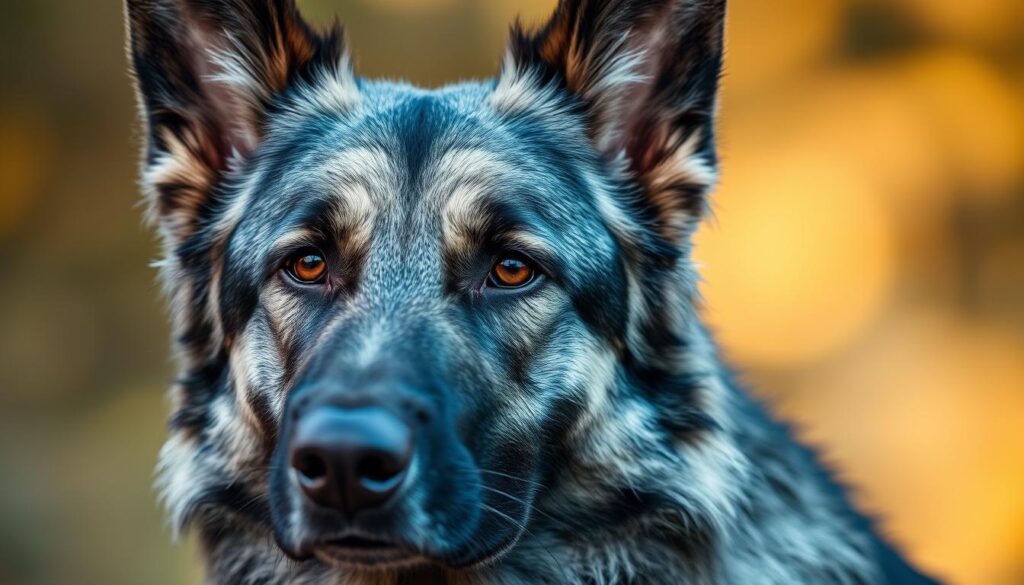
Coat Colors and Patterns
The signature hue results from a dilution gene affecting pigment distribution. You’ll find three primary variations:
- Steel blue: Deep charcoal tones with metallic sheen
- Powder blue: Lighter, almost silvery appearance
- Blue silver: Mid-tone blend with cool undertones
Their double-layered coat—dense underfur with a slightly longer topcoat—comes in short or long-haired versions. Common patterns include blue and tan (gray base with caramel accents) and blue panda (distinctive facial markings).
Facial Features and Build
These dogs carry the breed’s hallmark traits:
- Angular muzzle with a strong jawline
- Alert, triangular ears standing erect
- Muscular shoulders and sloping back
Males typically reach 24-26 inches tall and weigh 65-90 pounds, while females stand 22-24 inches tall at 50-70 pounds. Their athletic build supports endurance tasks, from obedience drills to agility courses.
Temperament, Training, and Exercise Essentials
Raising a well-adjusted working dog requires understanding their natural drive. Blue GSDs inherit the breed’s signature intelligence and loyalty, but their energy demands smart channeling. Let’s explore how to build trust while meeting their physical needs.
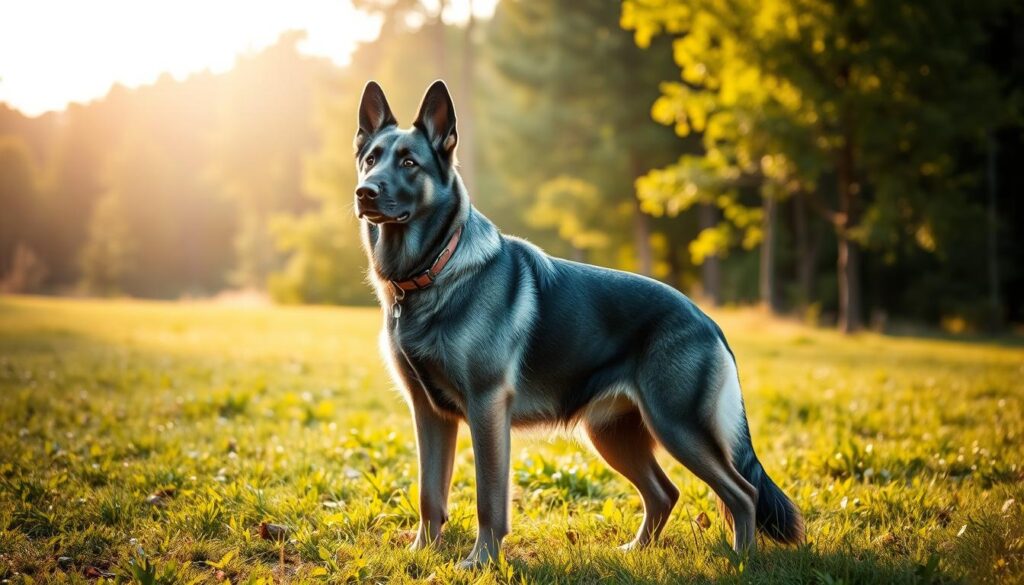
Obedience Training and Socialization
Start training before 16 weeks old when puppies absorb commands like sponges. Use reward-based methods with treats or toys to reinforce desired behaviors. Crate training helps establish boundaries, while controlled exposure to strangers prevents territorial instincts from becoming problematic.
These dogs thrive when given jobs. Consider advanced activities like:
- Agility courses (45% show improved focus)
- Scent detection games
- IPO protection for sports
Daily Exercise Requirements
Plan 60-90 minutes of mixed activities daily. Morning walks alone won’t cut it – their working heritage craves purposeful movement. Alternate between:
- 30-minute jogs
- Interactive fetch sessions
- Puzzle feeders for mental challenges
Dogs lacking stimulation often dig or chew destructively. Pair physical exertion with obedience drills to engage both body and mind. Remember: A tired GSD is a happy companion.
Health, Nutrition & Grooming Needs
Proactive care keeps your steel-coated companion thriving. While these athletic dogs share similar health profiles with standard GSDs, their unique genetics require tailored attention. Let’s break down how to maintain peak condition through prevention and routine care.
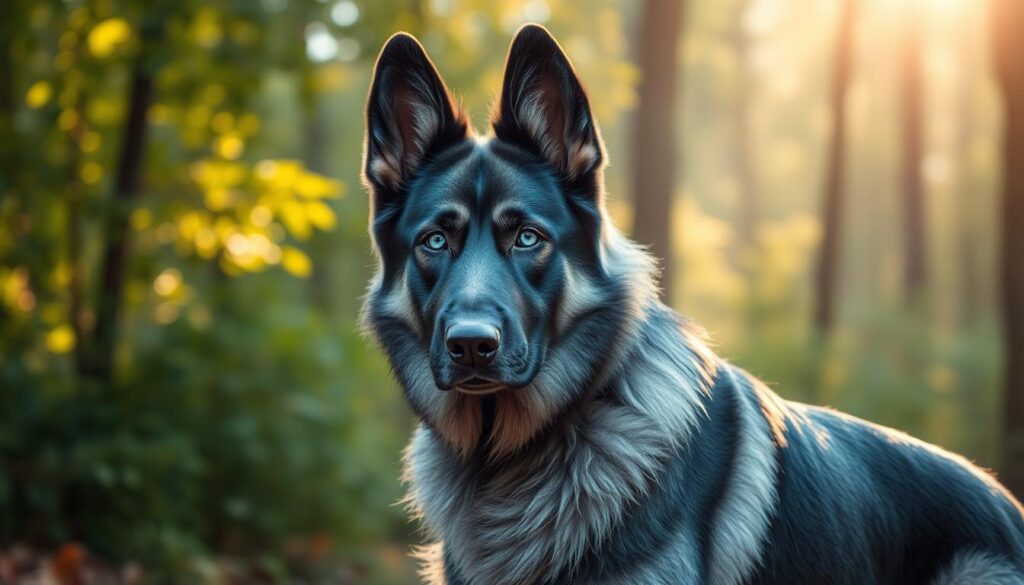
Common Health Issues
Three conditions demand regular monitoring:
- Hip/Elbow Dysplasia: Affects 19% of GSDs – X-rays at 2 years help detect early signs
- Color Dilution Alopecia: Causes patchy fur loss in 70% of dogs with dilution genes
- Digestive Sensitivities: Often linked to food allergies or improper diets
Annual vet checks catch 83% of issues before they become severe. During visits, ask about cardiac screenings and eye exams.
Balanced Diet and Joint Support
Feed high-quality kibble with:
- 25-30% animal protein (chicken, salmon)
- 15% healthy fats (fish oil, flaxseed)
- Glucosamine supplements for cartilage health
Puppies need calcium-rich meals three times daily, while adults thrive on two measured portions. Avoid fillers like corn—they trigger skin irritations in 40% of cases.
Grooming: Short vs. Long Haired Varieties
Brushing frequency changes with coat type:
- Short-haired: Weekly sessions remove loose fur
- Long-haired: Brush every other day to prevent mats
Bathe monthly with oatmeal shampoo to maintain skin pH. Trim nails every 3 weeks and brush teeth 4x weekly to prevent periodontal disease – 80% of GSDs develop dental issues by age 3.
Pricing, Breeder Tips and Ownership Insights
Bringing home a steel-coated companion involves more than just initial costs—it’s a lifelong commitment to their well-being. Let’s break down what you should expect financially and how to find trustworthy partners in your journey.

Understanding the Cost Factors
Pet-quality puppies typically range from $1,500-$2,500, while show-quality dogs can exceed $5,000. Three elements drive pricing:
- Pedigree documentation proving lineage
- Coat rarity within breeding lines
- Breeder’s reputation and location
Budget an extra $800-$1,200 annually for essentials like premium food, training sessions, and vet visits. Liver-colored variants often cost 15-20% less than blue-and-tan patterns due to lower demand.
Choosing a Reputable Breeder
Always verify health clearances for hip dysplasia and degenerative myelopathy. Ethical breeders:
- Provide DNA test results for both parents
- Allow onsite visits to meet puppy litters
- Offer post-adoption support contracts
Check the American Kennel Club’s marketplace for vetted professionals. Avoid sellers offering “rare” colors at steep discounts—this often signals irresponsible practices. Your due diligence today prevents heartache tomorrow.
Variations, Genetics, and Color Insights
The spectrum of steel-gray coats reveals fascinating genetic artistry. While these canines share core breed traits, their coloration patterns showcase nature’s paintbrush at work.
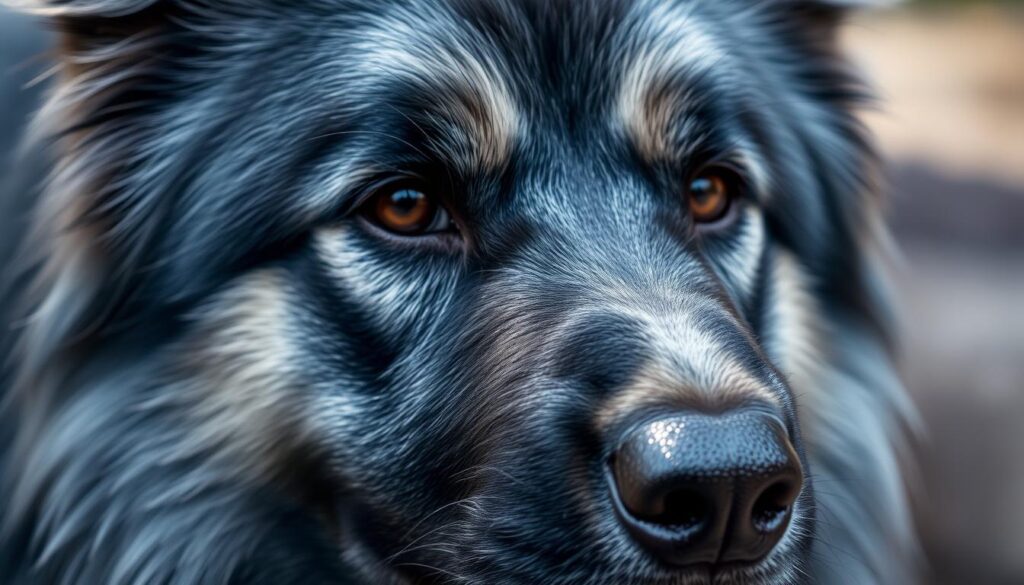
Different Blue Variations in the Breed
Four distinct patterns emerge from the dilution gene’s influence:
- Blue & Tan: Steel-gray base with caramel accents on legs and face
- Blue Panda: Dramatic facial masking resembling raccoon markings
- Blue Liver: Warmer taupe tones from combined dilution and liver genes
- Blue Merle: Mottled pattern (only in mixed lineages)
Shades range from deep gunmetal to light silver, depending on genetic combinations. A sable GSD carrying the dilution gene might display smoky guard hairs over a lighter undercoat.
The Blue Dilution Gene Explained
This recessive D locus gene transforms black pigment into muted tones by altering melanin distribution. As canine geneticist Dr. Linda Weiss notes:
“The dd genotype doesn’t just change color – it creates an optical illusion of metallic sheen through modified hair structure.”
Three factors determine final coloration:
- Number of dilution alleles inherited
- Interaction with other color genes
- Sunlight exposure’s fading effect
Understanding these mechanics helps owners verify authentic lineage and set realistic expectations. Whether your companion sports steel-gray paws or a powder-blue saddle mark, their working instincts remain uncompromised. Focus on health certifications rather than chasing specific shades – true quality shines through capability, not coat color.
Conclusion
Your steel-gray companion brings both beauty and responsibility. While their coat color stems from a rare genetic trait, these intelligent protectors share the same needs as any GSD. Consistent training, proper healthcare, and regular exercise remain crucial for their well-being.
Proactive care makes all the difference. Schedule annual vet checks to monitor common issues like hip dysplasia. Maintain their coat with weekly brushing and quality nutrition to support skin health. Remember—their striking appearance doesn’t change their fundamental care requirements.
Choosing a responsible breeder who prioritizes health certifications over coat color ensures you get a thriving partner. The American Kennel Club emphasizes selecting dogs based on temperament and physical soundness, not just unique coloring.
With dedication, your loyal companion will excel as a family guardian or agility champion. Focus on building trust through positive reinforcement and meeting their mental stimulation needs. When cared for properly, these remarkable dogs prove that true beauty lies in their capability and character.
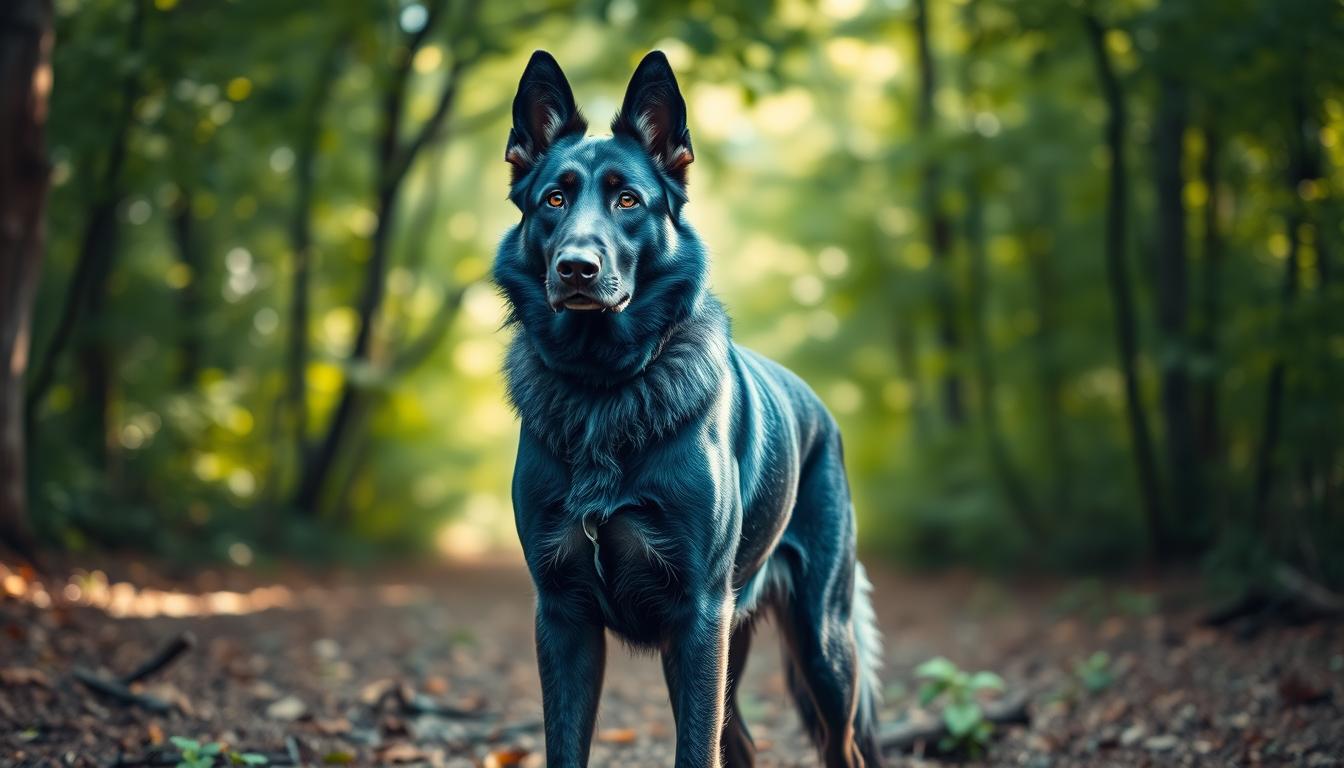
Every weekend i used to go to see this site, because i want enjoyment, for
the reason that this this website conations in fact fastidious funny material too.